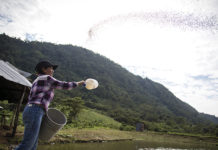After a cooped-up winter at home, you might be itching to schedule that family trip to Disney World, Six Flags, or Kalahari Resort. After all, COVID-19 cases have finally started declining, and venues nationwide tout new-and-improved safety precautions. But is it actually safe to visit theme parks or family entertainment venues right now?
Well, according to experts, it largely depends on the type of theme park you plan to visit. Keep reading to see considerations for safe family venues, and check out our ranking of the best—and worst—types to visit during the COVID-19 pandemic, including outdoor theme parks, indoor theme parks, waterparks, arcades, and more.
Safety Considerations for All Family Venues
When deciding whether to visit an entertainment venue, the most important factor is your family's comfort level. "I think that every family needs to consider their own risk, including risk of severe illness," says Stephanie Silvera, PhD, Professor of Public Health at Montclair State University. Other considerations include safety measures implemented at the venue, your travel plans, quarantine requirements, amount of necessary interaction with others, and levels of community transmission.
Safety Measures: Adhering to guidelines from the Centers of Disease Control and Prevention (CDC), most theme parks and family chains have implemented enhanced safety precautions to fight COVID-19 transmission. Regulations vary at each place, but it's safest to visit somewhere with mandatory mask mandates, enhanced disinfection protocols, social distancing requirements, temperature screenings, and limited capacities.
Travel Plans: Many families commute great distances to visit theme parks—and certain types of travel are riskier than others. For example, you might want to reconsider flying on airplanes, "where you will be in an enclosed space with others who may or may not be wearing their masks consistently and correctly," says Dr. Silvera. "Driving could reduce risk, though with stops along the way, the risk will not be zero." It's important to note that the CDC advises against any travel during this time.
Quarantine Requirements: Some states have strict quarantine protocols for visitors. For example, if you plan to visit Maine, you must fill out a certificate of compliance stating that you received a negative COVID-19 test or will complete a 10-day quarantine. These restrictions help keep your destination safer, but they might put a damper on your travel plans.
Amount of Necessary Interaction: COVID-19 mainly spreads through close contact—defined as being within 6 feet of an infected person for at least 15 cumulative minutes over 24 hours, says the CDC. Certain types of venues, like indoor theme parks with long lines for attractions, might require close contact with other patrons.
Levels of Community Transmission: If the amusement park or family entertainment venue is somewhere with high levels of community transmission, your family probably has a greater chance of contracting COVID-19.
Keep reading to learn about the best and worst types of theme parks and attractions to visit during the COVID-19 pandemic.

Outdoor Theme Parks
From Disney World and Universal Studios to Six Flags and Busch Gardens, outdoor theme parks are probably your safest bet during the coronavirus pandemic. That's because being outside helps dilute the virus. "We know that outdoor spaces are lower risk than indoor spaces, particularly if people are wearing their masks and if spatial distancing is enforced," says Dr. Silvera.
Still, make sure the venue is taking the pandemic seriously wth safety protocols. Disney World, for example, implemented enhanced cleaning procedures and set up barriers for physical distancing. It also promotes cashless transactions, enforces mask mandates, and requires temperature screenings at various locations.
"Given the new variants, my recommendation would be to be sure to wear tight-fitting masks (no gaps at the nose or cheeks) and/or double masking" at these outdoor venues, says Dr. Silvera. "Choose to dine outdoors whenever possible to lower risk and keep hand sanitizer at the ready.
Indoor Theme Parks
Indoor theme parks have one major disadvantage: less ventilation, which could help the virus accumulate in the air. "Most indoor theme parks do not, and are unable, to open windows, which we know helps to reduce the spread of aerosolized particles," says Dr. Silvera. "Some indoor spaces have invested in ventilation systems that replace indoor air with outdoor air at a higher rate, but in these spaces, distancing and mask wearing becomes even more important."
If you really want to visit an indoor theme park, do your research beforehand. Look into the company's protocols for social distancing and face masks—and check reviews to ensure the mandates are actually being enforced. It also helps if indoor venues limit their number of guests. "Capacity does make a difference, and parents should ask indoor parks how many people are allowed in each day to help them determine their comfort level before booking," says Dr. Silvera.
Waterparks
Universal Orlando Resort's Volcano Bay Water Park and Walt Disney World's Blizzard Beach Water Park both plan to open soon (February 27 and March 7, respectively). Indoor water park resorts—like Kalahari and Great Wolf Lodge—are also open for patrons. But should you visit these attractions?
According to the CDC, the actual water is probably safe. "CDC is not aware of any scientific reports of the virus that causes COVID-19 spreading to people through the water in pools, hot tubs, water playgrounds, or other treated aquatic venues," says the organization.
But here's the problem: Wet masks make breathing difficult, and they're less likely to work properly, so it's not advised to wear them in the water. Lack of masks could increase your family's exposure to COVID-19—especially in areas where social distancing is difficult."Indoor water parks are trickier because you are indoors without a mask with people you don't live with and that is automatically a higher-risk environment," adds Dr. Silvera.
Family Chains
If you're postponing your theme park or waterpark trip, you might think that local family entertainment chains are a safer bet (for example, Dave & Busters and Chuck E. Cheese). You probably don't need to worry about high-touch surfaces—like arcade games and play places—at these types of places. "While surface transmission is possible with this virus, it isn't the primary (or even a common) mode of transmission, particularly if people are washing/sanitizing their hands often, wearing a mask, and avoiding touching their face," says Dr. Silvera.
However, other modes of COVID-19 transmission—like direct contact or airborne spread—could still be possible without proper safety protocols. It pays to do your research and ensure the venue has mandates for face masks, social distancing, and maximum capacities. "Particularly for indoor venues, families should be looking closely at stated capacity guidelines for both the entertainment spaces as well as any restaurants/food services provided within the venue," says Dr. Silvera. "And while many venues have stated mask mandates, check the reviews to see if those mandates are being enforced."
Dr. Silvera also recommends asking about the venue's ventilation systems, since improper ventilation can increase the risk of COVID-19 transmission.
The Bottom Line
After being stuck at home for nearly a year, it's completely understandable that parents need a break—but now is not the time to let your guard down. "My recommendation would be to opt for outdoor activities as much as possible, especially if you can travel to them safely," says Dr. Silvera. "If you choose an indoor activity, try to avoid crowded spaces that don't allow for mask wearing and spatial distancing."
































